Predicting where anthropogenic debris accumulates in aquatic ecosystems is necessary for its control and environmental remediation, but plastic and fiber pollution in lakes is not well studied. A study published in PLOS Biology by Andrew Tanentzap at University of Cambridge, United Kingdom and colleagues suggests that microparticle concentrations in lakes are higher than previously reported, and that human activity and surrounding land use may be a strong predictor of microplastics and anthropogenic fiber pollution.

Credit: Tanentzap AJ et al., 2021, PLOS Biology, CC BY 4.0 (https://creativecommons.org/licenses/by/4.0/)
Predicting where anthropogenic debris accumulates in aquatic ecosystems is necessary for its control and environmental remediation, but plastic and fiber pollution in lakes is not well studied. A study published in PLOS Biology by Andrew Tanentzap at University of Cambridge, United Kingdom and colleagues suggests that microparticle concentrations in lakes are higher than previously reported, and that human activity and surrounding land use may be a strong predictor of microplastics and anthropogenic fiber pollution.
Plastic microparticles are ingested by a range of animals including large vertebrates and can deteriorate water quality. However, little is known about how human activity affects the concentration of microparticles in lakes. To better understand the accumulation of plastic and fiber particles in lakes, researchers trawled the surface waters of 67 European lakes between April and September 2019, spanning 30° of latitude in a range of environments. They counted the microparticles in these lakes under a microscope and with chemical analyses and measured lake water quality. The authors then fitted a model to their field data as well as synthesized, published data from over 2,100 net tows. They also tested if pollution was more common in lakes that were surrounded by lands where more waste was generated according to an existing computer model.
The authors found that concentration of water microparticles quadrupled in areas with more human activity and doubled in areas with lower forest cover. The study excluded macroparticles greater than 5 mm which can still be harmful to the environment, which may have led to an underestimation of plastic accumulation. The authors also found five times fewer microparticles in lakes with more active microorganisms, suggesting some naturally occurring species can help remove pollution. Future studies are needed to isolate microorganisms from the natural environment and test their ability to degrade microplastics and fibers.
According to the authors, “Our study provides a valuable evidence base to help prioritize monitoring and mitigation of anthropogenic debris in the world’s lakes. As anthropogenic debris continues to pollute the environment, our data will help contextualize future work, and our models can inform control and remediation efforts”.
“Most of our attention on plastic pollution focuses on the oceans, but we discovered that Europe’s lakes – our drinking water sources – are similarly polluted by microscopic plastics and man-made fibers,” Tanentzap adds. “Our study can now help direct control and remediation efforts by identifying hotspots of microparticle pollution based on surrounding land use and
water quality.”
#####
In your coverage please use these URLs to provide access to the freely available articles in PLOS Biology: http://journals.plos.org/plosbiology/article?id=10.1371/journal.pbio.3001389
Citation: Tanentzap AJ, Cottingham S, Fonvielle J, Riley I, Walker LM, Woodman SG, et al. (2021) Microplastics and anthropogenic fibre concentrations in lakes reflect surrounding land use. PLoS Biol 19(9): e3001389. https://doi.org/10.1371/journal.pbio.3001389
Funding: This work was funded by the Horizon 2020 European Research Council Starting Grant 804673 sEEIngDOM and an Isaac Newton Trust Research Grant 19.23(s) to AJT. CMP and ER were supported by the UK Research and Innovation Cambridge Creative Circular Plastics Centre (grant EP/S025308/1). The funders had no role in study design, data collection and analysis, decision to publish, or preparation of the manuscript.
Journal
PLoS Biology
DOI
10.1371/journal.pbio.3001389
Method of Research
Observational study
Subject of Research
Cells
COI Statement
Competing interests: The authors have declared that no competing interests exist.




